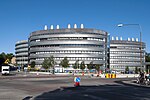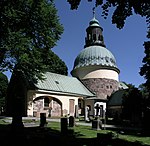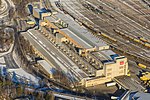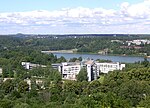Norra begravningsplatsen
1827 establishments in SwedenBuildings and structures in Stockholm CountyCemeteries in SwedenMetropolitan StockholmTourist attractions in Stockholm County

Norra begravningsplatsen, literally "The Northern Cemetery" in Swedish, is a major cemetery of the Stockholm urban area, located in Solna Municipality. Inaugurated on 9 June 1827, it is the burial site for a number of Swedish notables.
Excerpt from the Wikipedia article Norra begravningsplatsen (License: CC BY-SA 3.0, Authors, Images).Norra begravningsplatsen
Minneslundsvägen, Solna kommun
Geographical coordinates (GPS) Address Nearby Places Show on map
Geographical coordinates (GPS)
| Latitude | Longitude |
|---|---|
| N 59.356666666667 ° | E 18.019166666667 ° |
Address
Lindhagens kulle
Minneslundsvägen
171 48 Solna kommun, Solna Kyrkby
Sweden
Open on Google Maps









